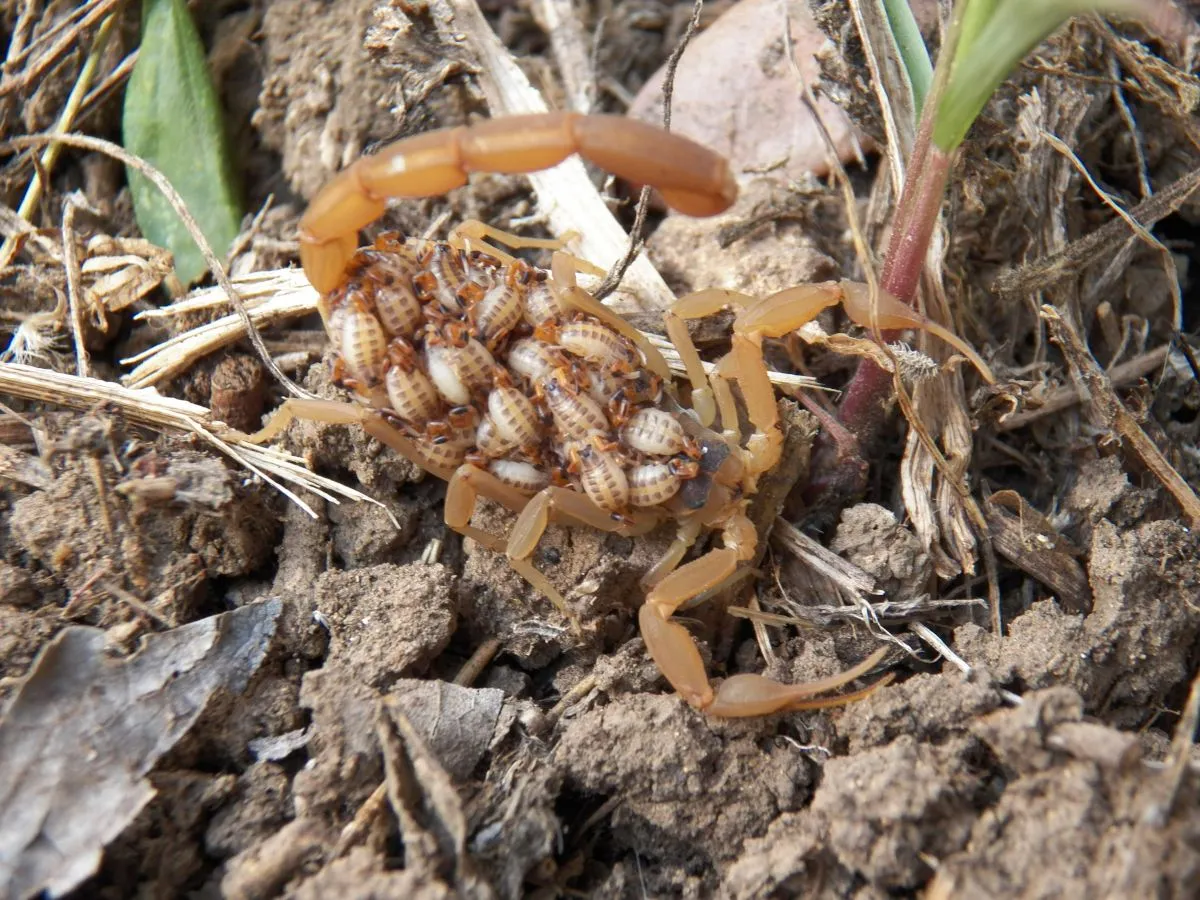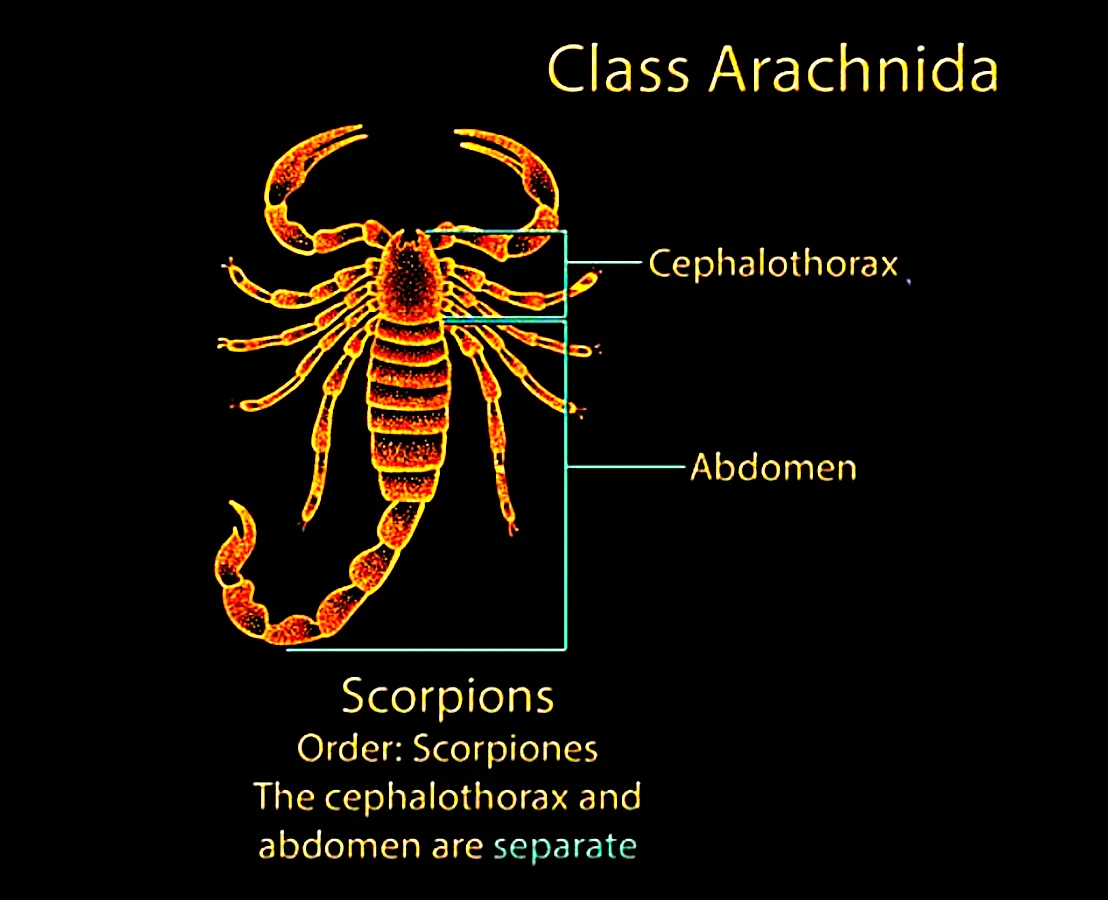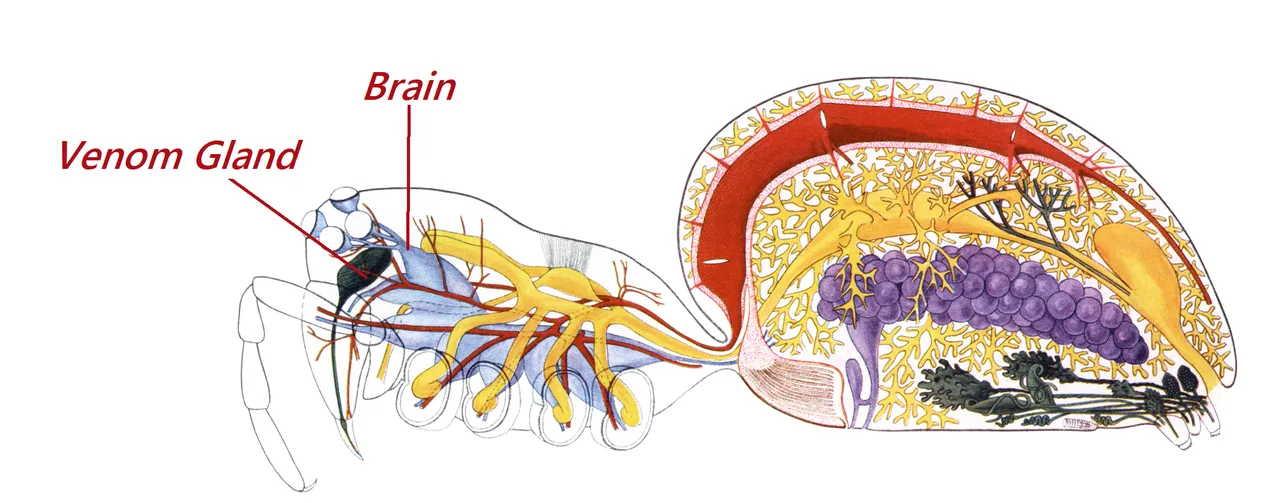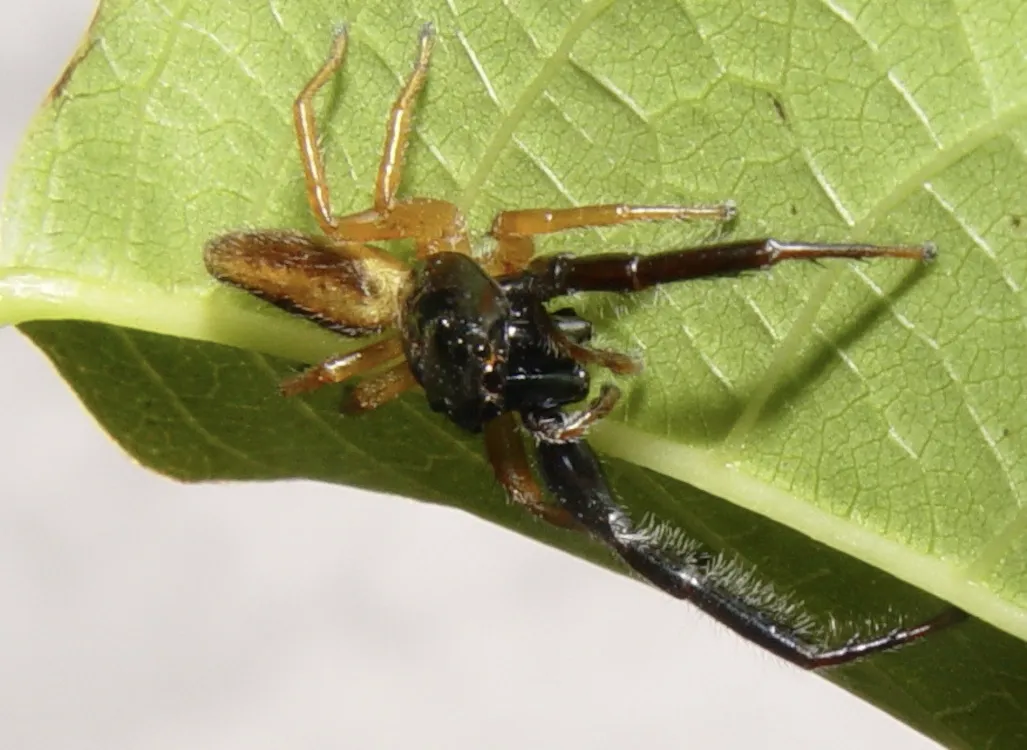The idea for this blog came to me after I made a collage in which a scorpion juggles. I wondered, when I finished the collage, how intelligent are scorpions?

Image credit: JawnTEM. Used under a CC 3.0 license. Scorpions give birth to as many as 100 young at one time. The young are carried on the mother's back for 10 or 20 days because they have not yet developed an exoskeleton. Once they do, they crawl off and begin life on their own. Mother will not eat them (!) unless she has no other food. However, a scorpion can go up to 12 months without eating, so the babies might be OK.
After doing some reading, I found nothing that told me specifically about scorpion intelligence. The only relevant bit of trivia I came up with was a reference to scorpion suicide. If scorpions could be so frightened, so upset, that they sting themselves to death, that would indicate the ability to form a plan and carry it out. It would also indicate that scorpions have emotions. This would be an indication not only of intelligence, but of sentience. The question of sentience in (nonhuman) animals has received a lot of attention of late. It is an issue to which I have personally given much thought.
However, reports of scorpion suicide were not helpful in determining sentience of the animal. These reports turned out to be urban myth. Scorpions are immune to their own venom.

Image credIt: Rosa Pineda. Used under CC 3.0 license. This is one of the largest scorpions in the world. It is found in Africa. Despite its size, the scorpion is not considered dangerous to humans.
Are scorpions intelligent? Are they sentient beings (Do they have consciousness, an awareness of their existence)? Is there a way to ascertain intelligence, or sentience, in nonhuman animals? These questions are not esoteric, or an academic exercise. They have implications in the real world, for animals and for human behavior toward animals.
The catch with this issue is this: not only is no one studying sentience in the vast majority of animal species in the world, most of the species (estimated at 8.7 million), have not been identified. The lack of information about sentience and intelligence is especially true when it comes to invertebrates. Without those studies, animals will receive no legal protection, no acknowledgment of a right to humane treatment.

Is there a way to assess the scorpion's sentience and win for it at least acknowledgment that it is entitled to humane treatment, that it exists in our moral circle?
According to the peer-reviewed journal Animals, ”...animal sentience refers to the ability of animals to experience pleasurable states such as joy, and aversive states such as pain and fear." The problem with assessing sentience in animals is, how do we do it? Even determining pain and awareness in humans is challenging. Neuroscience is trying to develop metrics for pain evaluation in noncommunicative (human) patients. There is no certainty that current methods are reliable.

As is true for assessing human distress/pain, determining the existence of this experience in animals is largely an unmet challenge. One method for acquiring this information is to observe changes in the parts of the brain associated with distress/pain. Unfortunately, with animals, especially with invertebrates, the “brain” may be very different from what we are familiar with in humans.
Scorpion Brain

Image credit: U. S. Public Health Library. Public domain
In a scorpion, there no 'head' as we are accustomed to thinking of this appendage. The scorpion head, as it were, is contained in the cephalothorax. The brain consists of "two large ganglia that surround the esophagus. One section of the brain interprets optical sensory and is the source of complex behaviors. The other part of the brain controls movement."(Information derived from Studies of the Nervous System, on Weebly)
In humans, response to pain is often assessed by observing changes in the cerebral cortex. However, there is no cerebral cortex in an invertebrate brain. The absence of a human-like brain structure has led in the past to the belief that invertebrates do not have the neural structure that allows for the experience of emotions. Having come to that conclusion, researchers decided that inveterbrate animals could not suffer. In the handling of invertebrates, whether in general commerce or in research, there was no need for humane considerations, because these simple creatures could not suffer.

Perhaps we should not be surprised to learn that the anthropomorphic position (if it doesn't look like a human it can't feel like a human) about invertebrate suffering has been debunked. Certain invertebrate, researchers have determined, do suffer. They are sentient. Given the paucity of studies, however, this designation covers only a few species.
Last week there was a seismic shift in the area of animal sentience. The UK government moved to issue protections (without force of law) to cephalopod molluscs and decapod crustaceans. These animals will now be included in the U.K.'s Animal Welfare (Sentience) Bill. The move follows a declaration by the London School of Economics and Political Science (LSE) that these creatures are sentient beings.

How do scorpions fit in the picture? Scorpions, it turns out, are neither decapods nor cephalopds. Scorpions are arachnids, related to spiders. If we don't know much about scorpion intelligence, how about spiders?
Fortunately (for my investigation), there is research on spiders which sheds light on their intelligence. It was recently reported that though spiders have minuscule brains, they are intelligent. Most intelligent are those that hunt, rather than those that wait passively for prey.

Image credit: John Henry Comstock public domain. Location of brain and venom sack derived from biologywise.com
The argument for spider intelligence is pretty well established, and the case for sentience is growing. An article in AnimalsAsia suggests that spider self-awareness is demonstrated in Peruvian spiders that create decoys. The authors write:
For a spider to make a decoy statue of itself..., it must understand itself as an individual separate from the environment... It must know what it looks like, and that it sits in a web, and must know how to create the structure which represents itself – anecdotally demonstrating their capacity for self-awareness."
No doubt, there are researchers who would not make the leap of ascribing sentience to spiders. However, there is certainly an argument for the position. Can we extrapolate this position to scorpions? Let's look at their behavior.

Image credit: prof.bizzzarro. Used under CC 2.0 license. There are an estimated 2,200 scorpion species in the world. While variety in mating practices may be found, all scorpions seem to engage in a pre-mating ritual called a promenade à deux.. Very rarely, the female may eat the male after the fact. In some cases there is evidence of social behavior (sharing of food or burrows). (Information derived from an article by Joseph Castro on Live Science)
Scorpions hunt their prey. Hunting strategy varies by species and circumstance. According to an article in ScorpionWorlds, a scorpion may ambush its prey. It may use a variety of techniques to kill, depending on the characteristics of the prey. Quoting from the article, "Although they have the same resources, not all hunt in the same way.”
For larger scorpions, tearing the prey apart with pincers is effective. For smaller scorpions, such as juveniles, envenomation is required to immobilize the victim. After the prey animal is subdued with venom, the scorpion sets about the final coup de grace. In the case of emperor scorpions, the young are large enough to use both techniques. They may sting prey and then attack, or they may simply attack and overwhelm prey with their larger size. They would rather conserve venom than use it, because creating venom is metabolically costly.
Scorpions use strategy. They vary technique depending on circumstance.
Scorpion Tactical Defense: Squirting Venom

Image credit: Ian Alexander. Used under CC 4.0 license. One of the defensive tactics a scorpion might use is to squirt venom from its stinger. According to an article in the journal "Behavioral Processes", "venom spraying might be useful as an antipredator function and can be modulated based on threat."
When it comes to defense, scorpions are, once again, strategic. According to Science Daily, scorpions choose one method of defense over another. Quoting from the article, which described observed behavior, “Scorpions usually selected their strongest defensive behavior; for instance, species with strong pincers more often used their pincers in defense”.
What I found very interesting is that the speed at which a scorpion delivers venom varies according to whether it is in a defensive situation or an offensive (hunting) situation. In offensive situations, the stinger is deployed deliberately, even slowly, and strategically. In defensive circumstances (survival on the line) "the stinger is rapidly launched towards the perceived threat, often without gripping the source of the threat with the chelae (pincers)."
Scorpion Intelligence and Sentience
Jumping Spider (Trite.planiceps)**

Image credit: Thomas Howard. Used under CC 1.2 license.
If we compare what we know about spider intelligence, and scorpion intelligence, it is obvious that both animals are engaged in similar hunt engagements and both are strategic predators. A clear case for intelligence in scorpions may be made indirectly. As for sentience:
It is beyond my ability to find anything that asserts scorpion sentience. If we infer (as I am inclined to do) that scorpion cognition implies sentience, then we may conclude that they are sentient beings. But there is no way I can prove this. Let me know, please, if you come up with specific information on the subject.

Conclusion
I've gone on a bit about scorpion sentience and some readers may ask, to what end? Are we not supposed to kill scorpions? Are we not supposed to kill arthropods, and all the millions of animals which may pose a risk to us or may provide nutrition? That is not the purpose of my blog. My blog simply posits the proposition that when we engage with animals, any animals, we should appreciate the possibility (indeed the likelihood) that they may suffer. As some sources are inclined to suggest, we ought to include them in our moral circle.




Credits/Sources
Images (not already credited in the blog):
Scorpion Accent
 Clikr-free vector image, Pixabay
Clikr-free vector image, Pixabay
Octopus Accent
 ArtsyBee on Pixabay
ArtsyBee on Pixabay
Selected Research Sources
1.https://study.com/academy/lesson/scorpions-life-cycle-reproduction.html)
2.https://www.pressreader.com/australia/science-illustrated/20140601/281874411485871
3.https://animals.sandiegozoo.org/animals/scorpion
4.https://cites.org/eng/gallery/species/invertibrate/emperor_scorpion.html
5.https://www.animal-ethics.org/sentience-section/introduction-to-sentience/problem-consciousness/
6.https://www.americanbar.org/groups/tort_trial_insurance_practice/publications/committee-newsletters/enshrining_animal_sentience_into_law/
7.https://www.bbc.com/news/science-environment-14616161
8.https://www.animal-ethics.org/sentience-section/animal-sentience/invertebrate-sentience-a-review-of-the-neuroscientific-literature/
9.https://www.ncbi.nlm.nih.gov/pmc/articles/PMC4494284/
10.https://www.tandfonline.com/doi/10.1080/09602011.2019.1614464
11.https://english.stackexchange.com/questions/207718/looking-for-a-common-word-meaning-hands-and-feet-as-well
12.https://nervousbiology.weebly.com/scorpion.html
13.https://www.nature.com/articles/s41598-020-62525-7
14.https://cob.silverchair-cdn.com/cob/content_public/journal/jeb/220/21/10.1242_jeb.151308/6/jeb151308.pdf?Expires=1641325231&Signature=dspysTgWXz2-UsB2-5MH4ep9N-4iqAf4XUtYtJwx3GqeiHX9EsKEzG7FLAbjCSXHHdP3MIrc4vsQF6cBZZ9890OSEfd2P6coB2DiMm5lNHda5DUh9bkfSmRG5g8r-hHPeKXjNTCXn2aQ3vm0PDzRbE9CL3oWApQS0VQWlAcuQxBdtgvO-bYpNlKs4gIcgHONPVe7Ayqpf-Hl21KGTJHAbQajVab84a8Noyqoy0PW9h36dSFV9XvsH7IAC34DA3DtZ2FXMZ4SWBFG8RdzY6ntLBjpBDHDP2ZxrLyLJpeUhbKhtO0P1QUSILy19minWaft0j19s2jWygH6~2Witg__&Key-Pair-Id=APKAIE5G5CRDK6RD3PGA
15.https://www.gov.uk/government/news/animals-to-be-formally-recognised-as-sentient-beings-in-domestic-law
16.https://knowablemagazine.org/article/mind/2021/are-spiders-intelligent
17.https://biologywise.com/anatomy-of-spiders
18.https://www.animalsasia.org/us/media/news/news-archive/self-aware-spiders-fascinating-arachnid-builds-its-own-lifelike-decoys.html
19.https://www.livescience.com/54981-animal-sex-scorpions.html
20.https://www.scorpionworlds.com/scorpion-feeding/
21.https://www.frontiersin.org/articles/10.3389/fevo.2019.00196/full
22.https://daily.jstor.org/how-does-a-scorpion-decide-when-to-sting/
23.https://www.sciencedirect.com/science/article/abs/pii/S0376635715000753
24.https://www.eurekalert.org/news-releases/625328
25.https://besjournals.onlinelibrary.wiley.com/doi/full/10.1111/1365-2435.12855
26.https://www.lse.ac.uk/News/News-Assets/PDFs/2021/Sentience-in-Cephalopod-Molluscs-and-Decapod-Crustaceans-Final-Report-November-2021.pdf
27.https://www.gov.uk/government/news/lobsters-octopus-and-crabs-recognised-as-sentient-beings?utm_medium=email&utm_campaign=govuk-notifications&utm_source=994c7ffd-9c00-4347-9563-bc9a0754ecad&utm_content=immediately
28.http://www.findaspider.org.au/info/spiderns.htm
29.https://askabiologist.asu.edu/scorpion-facts
30.https://leidenlawblog.nl/articles/why-should-non-human-animals-be-included-in-our-moral-circle